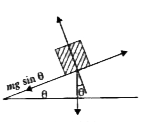A cyclist climbing on an inclined road maintains a constant of 9km/h. The total mass of the cycle and the cyclist is 100kg. If the angle of inclination is 20∘, what is the maximum power expended by the cyclist?
The cyclist moves with a constant speed. So the only force he has to exert is against gravity.
v=9khm−1=2.5ms−1
Power expended =F×v
=mgsinθ×v
=100×9.8×sin20×2.5
=837.9W

Topper's Solved these Questions
- DYNAMICSBOOK - ICSECHAPTER - DYNAMICSEXERCISE - CONCEPTUAL SHORT ANSWER QUESTIONS WITH ANSWERS
20 Videos
- DYNAMICSBOOK - ICSECHAPTER - DYNAMICSEXERCISE - SHORT ANSWER QUESTIONS
93 Videos
- DYNAMICSBOOK - ICSECHAPTER - DYNAMICSEXERCISE - SHORT ANSWER QUESTIONS WITH ANSWERS
12 Videos
- DIMENSIONSBOOK - ICSECHAPTER - DIMENSIONSEXERCISE - SELECTED PROBLEMS (FROM CONVERSIONS OF ONE SYSTEMS OF UNITS INTO ANOTHER)
9 Videos
- FRICTIONBOOK - ICSECHAPTER - FRICTIONEXERCISE - Selected problems
30 Videos
Similar Questions
A train moving at 15 m/sec takes 20 seconds to pass a cyclist moving in the same direction as that of the train. How much time will be train need to pass the cyclist, if the cyclist moves in a direction opposite to that of the train and if the speed of the cyclist is 5m/sec and the length of the cycle is 1 m? 9.95 sec b. 10 sec c. 10.05 sec d. 12 sec
View SolutionA cyclist covers a distance of 750 m in 2 min 20 sec. what is the speed in km/hr of the cyclist?
View Solution
Knowledge Check
A man cycling up a smooth inclne road, climbs the road at a constant spped of 2m/s. The total mass of the man and the cycle is 150 kg and the inclination of the road with the horizonal is 30∘. What is the minimum horse power spend by the man?
[Take g=10m/s2 and 1 horse power =750 watt]A1.25H.PB1.5H.PC2H.PD5H.PA cyclist moves with uniform velocity down a rough inclined plane of inclination α. Total mass of cycle & cyclist is m. Then the magnitude and direction of force acting on the cycle from inclined plane is :
Amgcosα perpendicularly into the inclined planeBmgcosα perpendiculary outward of the inclined planeCmg perpendicularly outward of the inclined planeDmg vertical upwardsWhat is the smallest radius of a circle at which a cyclist can travel if its speed is 36 km/h, angle of inclination 45∘ and g=10m/s2?
A20 mB10 mC30 mD40 m
Rain is falling vertically with a velocity of 4 km hr−1 . A cyclist is going along a horizontal road with a velocity of 3 km hr−1 towards cast. Calculate the relative velocity of the rain with respect to the cyclist. In what direction must the cyclist hold his umbrella to save himself from the falling rain ?
View SolutionA cyclist is going in a straight line at a unifrom velocity 18km/h. The resistance force can be expressed as force kv2 where k=0.8 where velocity is in m/s and unit of force is newton. The mass of the cyclist with the bicycle is 100kg. Neglect the rolling resistance force. If the power of the cyclist during the ride is 10x watt, then what is x ?
View SolutionA cyclist is moving with a speed of 20kmh−1 . How long will he take to travel a distance of 1.5 km ?
View SolutionWhat is the maximum speed with which a cylist can turn around curved path of radius 10.0 m, if the coefficient of friction between the tyre and the road is 0.5 ? If the cyclist wants to avoid overturning by what angle the cyclist must lean from the vertical ?
View SolutionA cyclist goes round a circular track of 440 metres length in 20 seconds Find the angle that his cycle makes with the verticle.
View Solution
